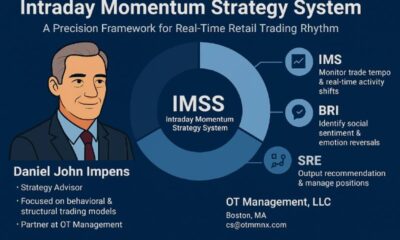Business
A Look at Why Investing in Your Employees Should Be a Top Priority

In today’s competitive business landscape, companies are constantly seeking ways to gain a competitive edge. While strategies like improving products or services, expanding market reach, and enhancing customer experiences are often at the forefront of business planning, one crucial aspect that shouldn’t be overlooked is investing in employees. Cultivating a culture of investment in your workforce can yield substantial long-term benefits for both employees and the organization as a whole.
Enhanced Employee Engagement and Retention
High turnover rates can wreak havoc on organizational stability and morale. However, by investing in employee development and well-being, businesses can foster a sense of loyalty and commitment among their workforce. Providing opportunities for career advancement, creating a supportive work environment, and offering recognition for achievements are essential elements in enhancing employee engagement and retention.
Employee financial wellness programs are particularly impactful in this regard. By offering resources and support for financial literacy, budgeting, and savings initiatives, companies demonstrate a genuine concern for their employees’ holistic well-being. Such programs not only alleviate financial stress but also strengthen employee loyalty and satisfaction, leading to higher retention rates and a more resilient workforce.
Increased Productivity and Innovation
Employees who feel invested are more likely to be motivated to perform at their best. By providing them with the necessary resources, tools, and support, companies can unlock their full potential and drive productivity gains. Furthermore, investing in ongoing training and skill development equips employees with the knowledge and capabilities to adapt to changing technologies and market dynamics, fostering a culture of innovation.
When employees are encouraged to think creatively and are empowered to contribute their ideas, it can lead to breakthrough innovations and process improvements that drive business growth. By investing in employees’ growth and development, organizations not only benefit from their individual contributions but also from the collective intelligence and creativity of their workforce.
Improved Customer Satisfaction
Employees are often the face of a company and play a significant role in shaping the customer experience. When employees feel valued and supported, they are more likely to deliver exceptional service and build meaningful connections with customers. Investing in customer service training, interpersonal skills development, and empowerment initiatives can help employees better understand and meet customer needs, ultimately leading to higher levels of satisfaction and loyalty.
Furthermore, engaged and satisfied employees are more likely to act as brand ambassadors, promoting the company’s products or services through positive word-of-mouth and social media advocacy. This can have a ripple effect, attracting new customers and enhancing the company’s reputation in the marketplace.
Strengthened Employer Brand and Competitive Advantage
In today’s job market, talented employees have more options than ever before. Companies that invest in their employees’ growth and well-being are viewed more favorably by job seekers and are better positioned to attract top talent. A strong employer brand built on a reputation for
investing in employee development can serve as a powerful recruiting tool, helping the company stand out from competitors and attract candidates who are aligned with its values and culture. Moreover, investing in employees can also contribute to a positive workplace culture characterized by trust, collaboration, and mutual respect. This, in turn, can lead to higher levels of employee satisfaction and engagement, further strengthening the employer brand and providing a competitive advantage in the talent marketplace.
Long-Term Sustainability and Success
Ultimately, investing in employees is not just about short-term gains but about building a foundation for long-term sustainability and success. Companies that prioritize employee development and well-being are better equipped to navigate challenges, adapt to change, and seize opportunities in an increasingly dynamic and competitive business environment.
By investing in employees’ growth, companies invest in their own future. Empowered, engaged, and skilled employees are the driving force behind innovation, customer satisfaction, and organizational performance. As such, investing in employees should be seen not as an expense but as a strategic investment with a high return on investment.
Conclusion
In conclusion, investing in employees should be a top priority for any organization committed to long-term success. By fostering a culture of investment in employee development, companies can enhance employee engagement and retention, drive productivity and innovation, improve customer satisfaction, strengthen their employer brand, and ensure long-term sustainability and success. In today’s rapidly evolving business landscape, the value of investing in employees cannot be overstated.
-

 Sports4 weeks ago
Sports4 weeks agoFIFA Club World Cup 2025: Complete List of Qualified Teams and Groups
-

 Sports3 weeks ago
Sports3 weeks agoAl Ahly vs Inter Miami, 2025 FIFA Club World Cup – Preview, Prediction, Predicted Lineups and How to Watch
-
Health2 weeks ago
Back to Roots: Ayurveda Offers Natural Cure for Common Hair Woes
-

 Tech2 weeks ago
Tech2 weeks agoFrom Soil to Silicon: The Rise of Agriculture AI and Drone Innovations in 2025
-

 Sports3 weeks ago
Sports3 weeks agoFIVB Men’s Volleyball Nations League 2025: Full Schedule, Fixtures, Format, Teams, Pools and How to Watch
-

 Startup3 weeks ago
Startup3 weeks agoHow Instagram Is Driving Global Social Media Marketing Trends
-

 Television4 weeks ago
Television4 weeks agoTribeca Festival 2025: Date, Time, Lineups, Performances, Tickets and How to Watch
-

 Sports3 weeks ago
Sports3 weeks agoWorld Judo Championships 2025: Full Schedule, Date, Time, Key Athletes and How to Watch













